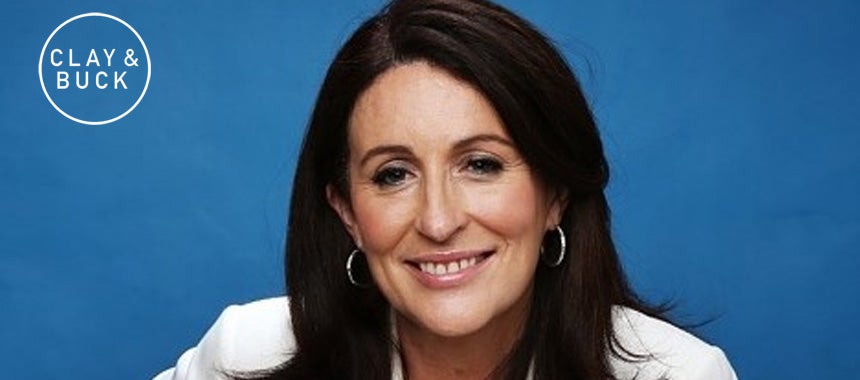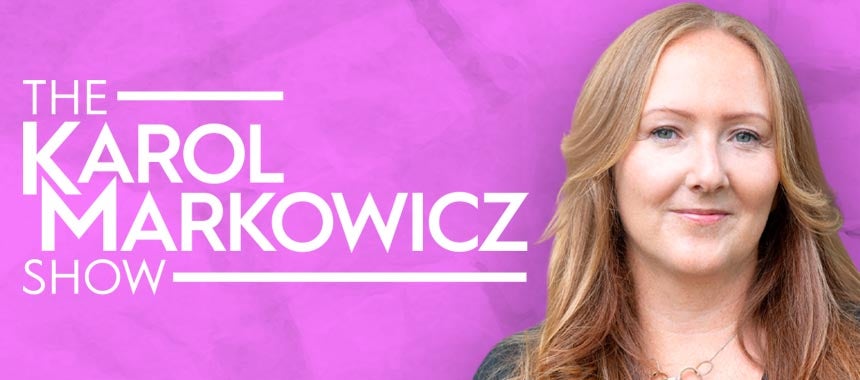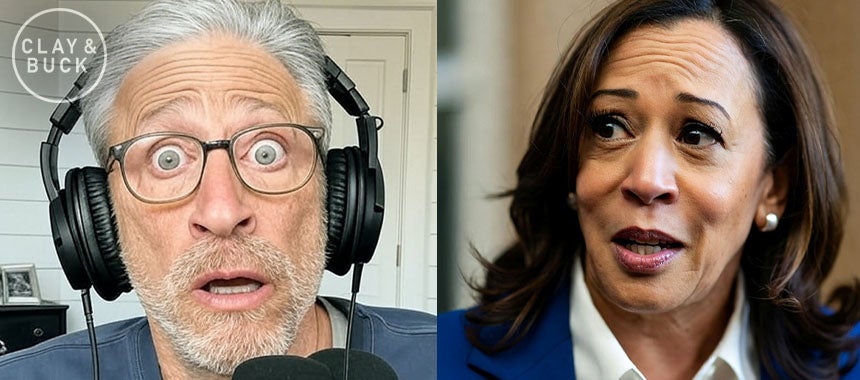Dr. Margery Smelkinson to C&B: Don’t Mask Kids in Schools
1 Feb 2022
CLAY: There was a fantastic story, fantastic story in The Atlantic titled, “The Case Against Masks at School.” We will retweet this once more. Both Buck and I shared it with all of you. It was written by Margery Smelkinson. She is an infectious disease scientist. She also wrote it with two other people: Leslie Bienen (a veterinarian) and Jeanne Noble, an emergency medicine doctor at UCSF. It is up at the Clay and Buck website.
You can click through to read it — it’s in The Atlantic — and we are joined now by Dr. Smelkinson. She’s an infectious disease scientist. Dr. Smelkinson, phenomenal work on this article laying out why masks in schools don’t make sense from a scientific basis. How long did you work on the piece, and what initially made you decide — along with your two colleagues — to write this article?
DR. SMELKINSON: Well, thank you for having me on. You know, we actually submitted this piece quite a while ago, and it went (chuckles) — you know, there’s a lot of fact-checking that goes on at The Atlantic. So, you know, it was really, you know, a nice piece that was put out in the end. But we… You know, at the beginning of the pandemic it made sense to do whatever we needed to do: Mask up, you know, take all the precautions. We didn’t know what was going on.
 But, you know, we missed a lot of logical off ramps to phase out some of these restrictions. You know, like, schools have been so restricted. But, like, once teachers and adults were, you know, able to get vaccinated pretty widely, that should have been an offramp to a lot of these things. But it really wasn’t, right? So we’re kind of at this turning point in the pandemic.
But, you know, we missed a lot of logical off ramps to phase out some of these restrictions. You know, like, schools have been so restricted. But, like, once teachers and adults were, you know, able to get vaccinated pretty widely, that should have been an offramp to a lot of these things. But it really wasn’t, right? So we’re kind of at this turning point in the pandemic.
Omicron is really forcing us to face that this virus is gonna be here forever. You know, it’s gonna circulate very much like the flu. And with cases easing and children now eligible to be vaccinated for about three months now, it’s really time to buckle down, figure out what is the best way forward and how to get these kids’ lives and their schools back to normal as quickly as we can, ’cause you know kids have been just through the wringer these last two years.
And this really involves digging into the data behind each mitigation measure and weighing whatever benefits they have at this point in time with the harms, and so that’s why we wrote this up. You know, we wanted to really dig into the data about masks. And there was, you know, several studies last year even pre-vaccine that showed that student masking made little difference in case rates within the schools.
And now this year, you know, nearly half of U.S. school districts don’t even have mask mandates. So we’re actually able to make these comparisons between districts that have them and that have mask optional policies. And again, you know, controlling for things like community transmission and vaccination rates, we’re again seeing very little difference. And there was also another report out of the U.K. — while we were writing this — that said very similarly that their schools that had mask mandates and those that didn’t had very similar numbers of covid-related absences.
And I would also note that the U.K. actually doesn’t typically mask kids under 12. They follow the WHO. So, you know, just compiling all this data together, it just seemed very weak to continue masking students, especially now that they can be vaccinated. And, you know, we have to keep in mind that a lot of districts don’t mask. Some countries never had masking of their students or their teachers. And, you know, it’s time to really pivot away from mask mandates at this point.
BUCK: One of the places where — and this is Buck, thanks for joining us — where you did the data crunching, I thought it was interesting ’cause I’ve seen this elsewhere as well and people line up the numbers and Los Angeles County and Orange County. And it’s fascinating ’cause they’re right next to each other and I know that some people who are very, I would say, not even just intellectually but emotionally invested in masks always have some answer for why, you know, the data doesn’t say what the data clearly says.
And in that case, and it’s one you dealt with in your article, is essentially effectively the same, right? I mean, the numbers aren’t ever going to be exactly the same for infectious rates of two different populations, but pretty much the same. When you present this to people, showing that a mask… Now, yes, vaccination rates were what mattered in hospitalization for Los Angeles and Orange County in California.
But when you present the mask issue and say, “Look. Orange County doesn’t have mask mandates in school; Los Angeles did. There was no discernible difference,” what do people that are really invested in this say to that research? I mean, I’m sure you got a lot of heat for this article. What’s their response to you just saying, “This is what the numbers are telling us, guys”?
DR. SMELKINSON: I mean, that’s why we had to put so much data into this piece, right? ‘Cause like, you know, one piece of data is not gonna convince anybody. So that’s actually why we crunched the numbers in Maryland as well. I live in Maryland, and so we have kind of —
BUCK: And Tennessee, right? I saw you did Tennessee, Williamson and —
CLAY: Which is, by the way, where I spoke. And that’s really jumped out to me about your article, Dr. Smelkinson. I live in Williamson County, which is directly south of Davidson County, and we have no mask mandate in the county of Williamson’ Davidson does. And again, the rates of impact, just like Orange County and L.A. County, are virtually nonexistent.

BUCK: But sorry. You were saying, what do they say to you in response to these multiple places where you’ve had no mask and mask data to look at?
DR. SMELKINSON: Well, I mean, as I was saying, like we needed to load this up with as many examples as we could because I think just seeing, you know, Los Angeles and Orange County is not gonna make difference. Seeing just Tennessee counties is not gonna make a difference. But if you hit them with lots and lots and lots of data points, it’s really hard to, you know, look away from it.
And, you know, I think in a there’s a lot of… You know, our health officials have kind of dug their heels in on masking. It’s been hard to change course. They keep banging the same drum. It’s hard to admit when you’re wrong. But I think that at this point, it’s kind of actually easy for people to see what is going on. They can… You know, if they’re in an area that has a lot of restrictions, you can just look to the neighboring state and see, “Oh, their schools are pretty normal.”
BUCK: Are you coming across people who see your research and are changing…? This is the key. This is what we really wanted to know about in response to your article: Are they changing their minds on this? Are they saying, “Oh, my gosh! You hit us with all this data; you’re right”?
DR. SMELKINSON: Actually, I mean, I’ve been reached out by a few people that were very much in like the “Who cares. Let’s keep the masks on.” They reached out to me and they’re like, “Really, you know, you put in so much data in there including, you know, stuff about the harms,” which perhaps we’ll get to, “that it’s really tough to deny at this point that mask mandates… It appears that the benefits have really been overstated, at least in a school setting.”
And so, you know, I also think that the placement in The Atlantic also helped, you know (chuckling), kind of like a left-leaning magazine. So I think that it did speak to a lot of people. But, of course, there’s also people giving heat. But the problem is, like, there’s just no offramp. And I think that that’s what’s so frustrating to a lot of parents at this point. It’s like the logical off ramp at this point was kids five and up can be vaccinated. They have that protection now.
I mean, they were always low risk, and now they’re even, you know, lower risk. So, you know, I think that it is speaking to a lot of people. Obviously, you know, after we published our piece, it was also cited in the New York Times, and NPR had a piece and the Washington Post. I think there’s a lot of people that are coming to the realization that we have to kind of walk away from these mad mask mandate policies — and, you know, of course everyone can continue to mask. But it will be mask-optional policies.
CLAY: Dr. Smelkinson, a couple of quick questions here. Do you or your colleagues who wrote this have children — and if so, what would your thought process be as to whether they should wear masks at school? And then a secondary part here, what are the harms, right? The idea is we need to wear masks, right? Because the argument of the pro-mask people is because it makes people safe from covid, what harms do wearing masks inflict on children?
DR. SMELKINSON: So the answer to your first question, we do all have children. I actually have four elementary children so it has been quite a two years.
CLAY: By the way, sorry. I want to cut you off. What do the moms say to you? ‘Cause if you got four elementary school kids; I’ve got two elementary school kids. moms and dads, they have to be coming to you all the time to ask you what you think about masking, right?
DR. SMELKINSON: They do. And in the beginning… Well, I mean, last year it was just about getting the schools open, right? (chuckles) You know, actually about masks, my stance has really evolved. You know, in the beginning I did support masks. You know, schools were opening elsewhere. They generally had masks. It’s like, “Okay, I’ll mask my kids. Just open my school. It will be a temporary thing.” But my stance has evolved.
You know, actually in the summer I wrote an op-ed saying we should, you know, drop mask mandates in Maryland because at that point, everyone 12 and up was eligible for vaccination. Maryland was very vaccinated. We had the lowest case count. It was really at least time to start the discussion, because masking kids for this long has never been done. You know, with masks, unlike some other mitigation measures that we’ve had, it’s really hard to quantify the downsides of masks because they’re harder to see, they’re more subtle, they may take years to manifest.
 And that’s why I actually think this mask debate has been so contentious just because many are just like, “Okay, wear the mask, whatever.” But two years of children learning masks from masked teachers, it is likely not just going to be a benign intervention. We’re already starting to see data that masks are, you know, there’s a uptick in speech delays and impact on language development, social-emotional connections.
And that’s why I actually think this mask debate has been so contentious just because many are just like, “Okay, wear the mask, whatever.” But two years of children learning masks from masked teachers, it is likely not just going to be a benign intervention. We’re already starting to see data that masks are, you know, there’s a uptick in speech delays and impact on language development, social-emotional connections.
And it’s not just little kids. It’s all kids. Actually, adults too. They obviously impede the ability to communicate. I find myself, you know… Until this pandemic, I didn’t realize how much I read lips, you know, when I’m talking to somebody. And, you know, it’s hard to communicate with masks. So if this is a mitigation measure that is really not backed up by robust data, we should trash it. (chuckles)
CLAY: This is fantastic, and I encourage everybody listening to us right now… Dr. Smelkinson, thank you for coming on. Thank you for you and your colleagues who wrote this article. We’re gonna share it widely and we appreciate your work.
DR. SMELKINSON: My pleasure. Thank you.
Recent Stories

Is the U.S. Military About to STRIKE Inside Venezuela?
Buck takes us deep into the escalating tensions between the United States and Venezuela.

Miranda Devine: The Shutdown Is About to Get Nasty
Miranda and Buck discuss the shutdown coming to a head and her recent interview with the Vice President JD Vance.

Karol Markowicz on NYC and the Hypocrisy of Liberals
Karol and Buck discuss the demise of their former home, New York City.

Kamala Still Defends Biden’s Mental Fitness -- Even Jon Stewart Isn't Buying It
Buck takes us on a strange trip with Kamala Harris.

VIP Video: Democrats Must Push Their Senators to End the Shutdown
The Democrats are starting to panic over the shutdown.





